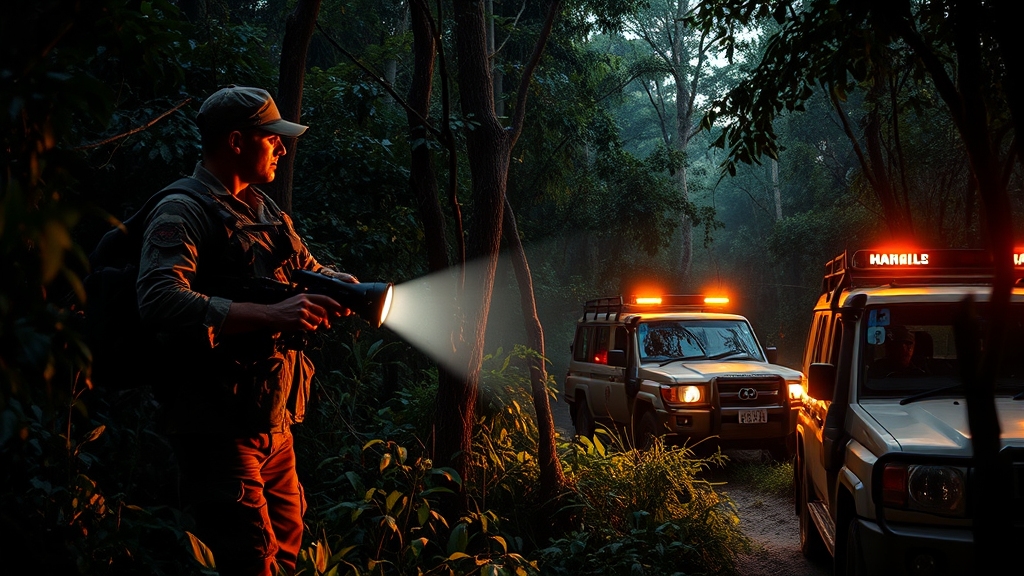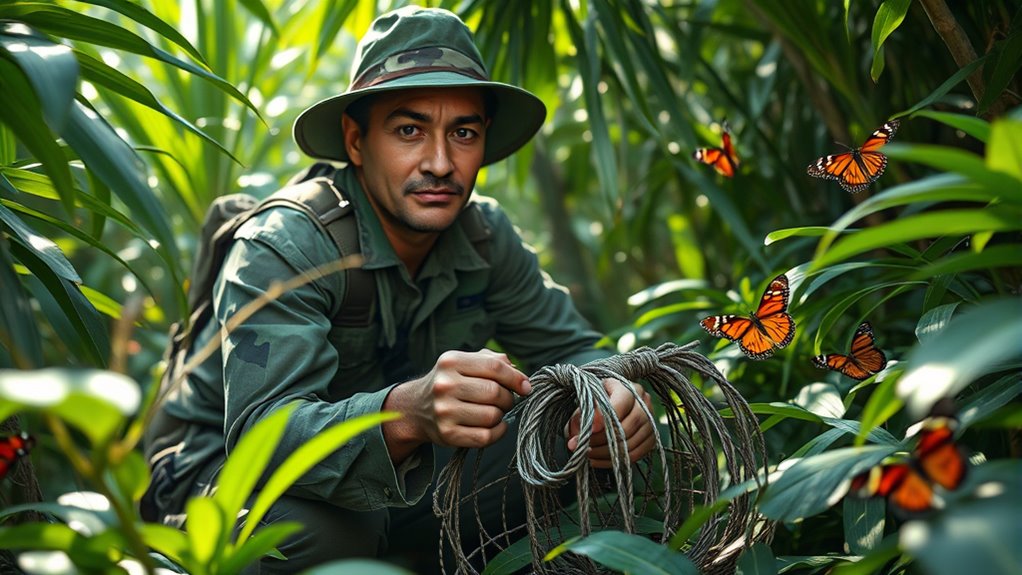To effectively fight wildlife crime, combine community engagement with advanced technology. Involving local communities helps protect land, share essential knowledge, and offer alternative livelihoods that reduce poaching incentives. Use tools like drones, infrared cameras, and GPS collars to monitor and detect threats in real time. Integrating these efforts creates a strong defense against poaching. Keep exploring to discover more strategies that make a real difference in wildlife conservation.
Key Takeaways
- Engaging local communities through education and alternative livelihoods fosters ownership and reduces poaching incentives.
- Utilizing drone surveillance, infrared sensors, and GPS collars enhances real-time monitoring and threat detection.
- Combining technological tools with community knowledge creates a comprehensive, proactive anti-poaching strategy.
- Data analytics and AI help predict poaching hotspots, optimizing resource deployment and prevention efforts.
- Continuous innovation and community involvement ensure sustainable and effective wildlife crime deterrence.

Have you ever wondered how conservationists combat illegal poaching? It’s a complex challenge, but one of the most effective strategies involves a combination of community engagement and technological innovations. These methods work hand-in-hand to protect endangered species and deter poachers from risking their lives for illegal wildlife trade. When you involve local communities, you’re not just creating a layer of protection; you’re fostering a sense of ownership and responsibility. Community members often have invaluable knowledge of the land and animal behaviors, which can be a game-changer in anti-poaching efforts. By providing alternative livelihoods, education, and incentives, conservationists turn potential poachers into guardians of their own natural resources. This approach reduces the economic pressures that drive illegal hunting, making it less attractive for those who might otherwise turn to poaching to survive.
Community involvement and technology are key to fighting illegal poaching effectively.
Technological innovations have revolutionized anti-poaching strategies. You might be surprised to learn how advanced tools like drone surveillance, infrared cameras, and GPS tracking are used to monitor wildlife and detect threats in real time. Drones can cover vast, hard-to-reach areas quickly, providing aerial views that spot poachers before they get too close to vulnerable animals. Infrared sensors can detect human presence at night, when poaching activities typically peak, alerting rangers immediately. GPS collars fitted on animals provide continuous data on their movements, helping rangers identify unusual patterns that could signal poaching attempts. These innovations profoundly increase the chances of intercepting illegal activities before they cause harm. Implementing technology is also essential in creating a comprehensive anti-poaching network that integrates various data sources for better decision-making. Additionally, the development of cybersecurity measures helps protect sensitive data from cyber threats and misuse, ensuring the safety of both wildlife and personnel. Moreover, data analytics and artificial intelligence are now being used to analyze patterns and predict poaching hotspots. This proactive approach allows conservation teams to allocate resources more efficiently and respond swiftly to threats. Utilizing remote monitoring can further enhance the ability to oversee large protected areas with minimal human presence, reducing risks and costs. The integration of technology with community-based initiatives creates a robust defense against wildlife crime. It’s not just about catching poachers; it’s about preventing crimes before they happen. When you combine the local knowledge and engagement of communities with cutting-edge technology, the impact is powerful and sustainable.
In essence, fighting wildlife crime requires a multifaceted approach that leverages both human and technological resources. When you support or participate in these efforts, you’re contributing to a future where endangered species can thrive free from the threat of illegal poaching. It’s a continuous battle, but with innovation and community involvement, real progress is within reach. Every effort counts, and together, we can make a difference in safeguarding the planet’s precious biodiversity.
Frequently Asked Questions
How Do Anti-Poaching Laws Vary Across Different Countries?
You’ll notice that anti-poaching laws vary widely across countries, often due to legal discrepancies and enforcement challenges. Some nations have strict penalties and robust enforcement, while others lack clear regulations or face corruption issues. These differences impact how effectively wildlife crimes are tackled. You can help by supporting organizations working to strengthen legal frameworks and improve enforcement, ensuring that anti-poaching laws are consistent and enforced worldwide.
What Role Do Local Communities Play in Anti-Poaching Initiatives?
Imagine local communities as the heartbeat of anti-poaching efforts. Your role in community engagement and local empowerment is vital; they become protectors rather than just observers. When you involve residents in conservation, you turn them into allies, sharing responsibility. This fosters trust, reduces illegal activities, and creates sustainable solutions. Empowered communities develop a keen sense of ownership, transforming their environment into a protected sanctuary driven by their commitment and knowledge.
How Effective Are Technological Tools Like Drones in Anti-Poaching Efforts?
You’ll find that technological tools like drones are highly effective in anti-poaching efforts. Drone surveillance allows you to monitor large areas quickly and discreetly, while sensor networks alert you to illegal activity in real time. These tools help you respond faster, deter poachers, and protect wildlife more efficiently. When you combine drone technology with sensor networks, you markedly improve your chances of catching poachers and safeguarding protected species.
What Are the Biggest Challenges Faced by Anti-Poaching Patrols?
You face many challenges in anti-poaching patrols, including habitat destruction that reduces wildlife spaces and makes detection harder. Corruption also poses significant obstacles, allowing illegal activities to continue unchecked. Limited resources and remote locations further strain efforts, making it tough to maintain consistent patrols. Overcoming these issues requires strong community engagement, better funding, and tackling corruption head-on to protect endangered species effectively.
How Can Individuals Support Anti-Poaching Campaigns Globally?
You can support anti-poaching campaigns globally by embracing eco-tourism and joining volunteer programs. When you choose eco-tourism, you contribute financially to conservation efforts, helping protect wildlife habitats. Volunteering your time and skills directly aids anti-poaching initiatives. Every effort counts—whether spreading awareness, donating funds, or participating in local conservation projects—because your actions inspire others and create a ripple effect, strengthening global wildlife protection efforts.
Conclusion
You can see that successful anti-poaching efforts do make a difference—communities involved in conservation programs have reduced illegal wildlife killings by over 50%. By supporting these initiatives, you’re helping protect endangered species and preserve ecosystems. Every effort counts, and your involvement can tip the scales against poaching. Together, we can guarantee a future where wildlife thrives, not just survives. Stay informed, stay engaged, and be part of the solution to fight wildlife crime.








